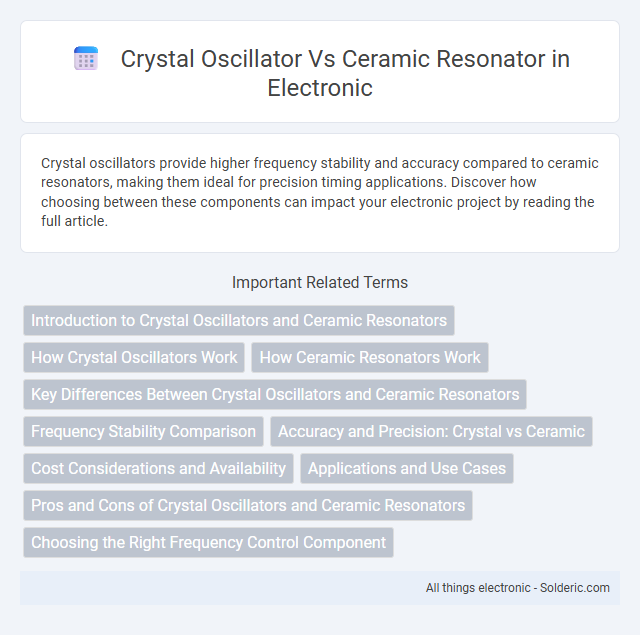Crystal oscillators provide higher frequency stability and accuracy compared to ceramic resonators, making them ideal for precision timing applications. Discover how choosing between these components can impact your electronic project by reading the full article.
Comparison Table
| Feature | Crystal Oscillator | Ceramic Resonator |
|---|---|---|
| Frequency Stability | High (+-10 ppm to +-50 ppm) | Moderate (+-0.5% to +-0.1%) |
| Frequency Range | Typically 1 MHz to 200 MHz | Typically 1 MHz to 30 MHz |
| Cost | Higher | Lower |
| Size | Larger | Smaller |
| Phase Noise | Low phase noise | Higher phase noise |
| Temperature Sensitivity | Low | Higher |
| Applications | Precision timing, communication devices | Microcontrollers, cost-sensitive applications |
Introduction to Crystal Oscillators and Ceramic Resonators
Crystal oscillators offer precise frequency stability by utilizing a quartz crystal's piezoelectric properties, making them ideal for high-accuracy timing applications. Ceramic resonators, based on piezoelectric ceramic materials, provide cost-effective solutions with moderate frequency stability, suitable for less demanding environments. Both devices convert electrical signals into mechanical vibrations, but crystal oscillators deliver superior frequency accuracy and stability compared to ceramic resonators.
How Crystal Oscillators Work
Crystal oscillators function by exploiting the piezoelectric properties of quartz crystals, which vibrate at precise frequencies when an electric field is applied. This stable mechanical resonance converts electrical signals into consistent oscillations, ideal for timekeeping and frequency control in electronic circuits. Your devices benefit from crystal oscillators' high accuracy and low frequency drift compared to ceramic resonators.
How Ceramic Resonators Work
Ceramic resonators operate using the piezoelectric effect in ceramic materials, which vibrate at a specific frequency when voltage is applied, generating a stable oscillating signal. These devices are commonly used in microcontroller clock circuits due to their cost-effectiveness and sufficient frequency stability for many applications. Your choice between a crystal oscillator and a ceramic resonator depends on the precision requirements, with ceramic resonators offering lower accuracy but greater durability and faster start-up times.
Key Differences Between Crystal Oscillators and Ceramic Resonators
Crystal oscillators offer higher frequency stability and precision compared to ceramic resonators, making them ideal for applications requiring accurate timing. Ceramic resonators are more cost-effective and provide good frequency stability for less demanding circuits, typically used in consumer electronics. Your choice depends on the required frequency accuracy, budget constraints, and the sensitivity of the application.
Frequency Stability Comparison
Crystal oscillators offer superior frequency stability compared to ceramic resonators, maintaining precise oscillation over a wide range of temperature and environmental changes. You can expect crystal oscillators to exhibit frequency stability in the range of +-10 to +-50 ppm, while ceramic resonators typically vary around +-0.1% (+-1000 ppm), making crystals ideal for applications demanding high precision. This significant difference in stability impacts the accuracy and reliability of timing circuits in communication, instrumentation, and microcontroller systems.
Accuracy and Precision: Crystal vs Ceramic
Crystal oscillators offer significantly higher accuracy and precision than ceramic resonators due to their stable quartz crystal structure, which provides frequency stability within +-20 ppm or better. Ceramic resonators, while more cost-effective, typically exhibit frequency tolerances of +-0.5% to +-0.1%, making them less suitable for applications requiring tight frequency control. The inherent low phase noise and temperature stability of crystal oscillators result in superior performance in timing-critical circuits compared to the more variable characteristics of ceramic resonators.
Cost Considerations and Availability
Crystal oscillators generally offer higher frequency stability and precision but come at a higher cost compared to ceramic resonators, which are more affordable and widely available in bulk. Ceramic resonators are preferred for cost-sensitive applications where moderate frequency accuracy suffices, making them common in consumer electronics and simple timing circuits. The availability of ceramic resonators is often greater due to their lower manufacturing complexity, while crystal oscillators may require specialized suppliers for niche frequency ranges.
Applications and Use Cases
Crystal oscillators are widely used in applications demanding high frequency stability and precision, such as in communication devices, microcontrollers, and timing circuits for GPS systems. Ceramic resonators suit low-cost and less precise applications like consumer electronics, small appliances, and automotive systems due to their moderate frequency stability and vibration tolerance. Their respective trade-offs determine selection based on accuracy requirements, environmental conditions, and budget constraints.
Pros and Cons of Crystal Oscillators and Ceramic Resonators
Crystal oscillators offer high frequency stability and precision, making them ideal for applications requiring accurate timing, but they tend to be more expensive and sensitive to mechanical shock. Ceramic resonators provide cost-effective solutions with moderate frequency stability and robustness against vibrations, though they exhibit higher frequency tolerance and phase noise compared to crystal oscillators. Your choice depends on whether you prioritize accuracy and stability or cost-effectiveness and durability in your electronic design.
Choosing the Right Frequency Control Component
Choosing the right frequency control component depends on your application's precision and stability requirements. Crystal oscillators offer higher frequency accuracy, lower phase noise, and better temperature stability, making them ideal for high-performance and timing-critical applications. Ceramic resonators, while less precise, provide cost-effective frequency control with faster start-up times and compact size, suitable for less demanding or budget-sensitive projects.
crystal oscillator vs ceramic resonator Infographic

 solderic.com
solderic.com